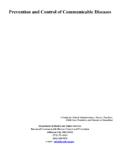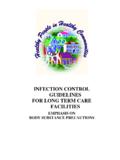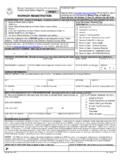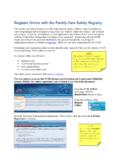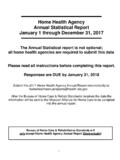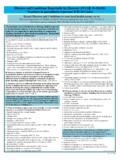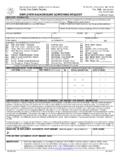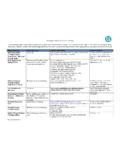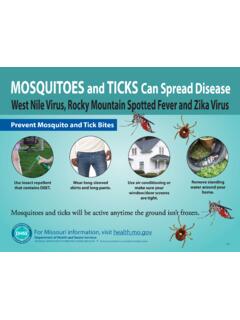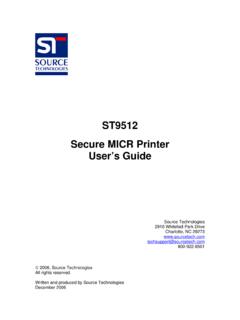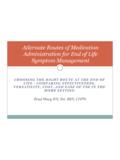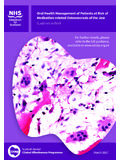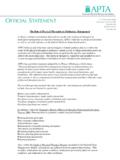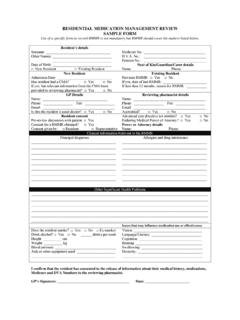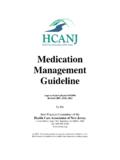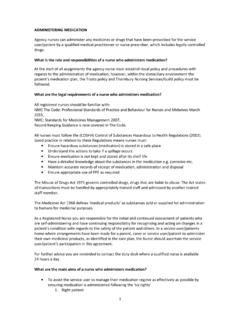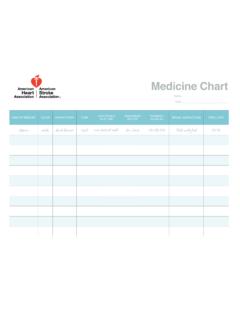Transcription of MEDICATION MANAGEMENT… BE SAFE & TAKE …
1 IN-HOME QUALITY IMPROVEMENT. MEDICATION management . BE safe & take . NURSE ENRICHMENT PROGRAM. 1. MEDICATION management Be safe & take . Nurse Enrichment Program Purpose: 1) To provide consistent instruction to nurses in MEDICATION assessment and clinical interventions 2) To improve management of medications in the home setting 3) To improve quality of life for patients receiving services Goal: To reduce avoidable hospitalizations by improving the home care patient's ability to safely prepare and take medications as prescribed _____Enrichment Activity #1. Pre-test: Complete Be safe & take Medications Competency _____Enrichment Activity #2. Review home health resources for: MEDICATION Assessment Protocol Interventions to Improve MEDICATION management Universal MEDICATION Form MEDICATION Discrepancy Tool MEDICATION Non-Adherence Tool MEDICATION Simplification Protocol _____Enrichment Activity #3.
2 Identify five potential interventions for helping your patients be safe and take their medications as prescribed _____Enrichment Activity #4. Post-test: Complete Be safe & take Medications Competency Nurse: Assess & Intervene Patient: Be safe & take 2. Enrichment Activity #1 & #4 (pre- and post-test). Be safe & take Medications Competency Directions: Choose the ONE BEST response to the following questions. Circle the letter that identifies the ONE BEST response. 1. MEDICATION reconciliation includes: A. Creating the most accurate list of patient's medications B. Providing a patient form to record all medications C. Resolving discrepancies D. Documenting only physician prescribed medications E. All of the above F. All but D. 2. If maintained properly, a Universal MEDICATION Form can: A. Reduce confusion and save time B. Improve communication between patient, family and healthcare providers C. Improve MEDICATION safety D.
3 All of the above 3. Actions to resolve MEDICATION discrepancies include: A. Advise to stop taking/start taking/change administration of medications B. Discuss potential benefits and harm that may result from non-adherence C. Talk to pharmacist about the problem D. Address performance/knowledge deficit E. All of the above F. All but C. 4. When selecting a type of MEDICATION box, you need to consider all of the following EXCEPT: A. Patient's ability to open the box B. Number of pills the patient takes in a day C. Size of the agency logo on the box D. Patient's visual ability 5. Your agency is requiring all nurses to use a new MEDICATION teaching tool as a guideline for patient education related to medications. You feel like you have always done a good job of patient education and feel resistant to use the new guideline. The purpose of having all nurses use the same guideline for MEDICATION teaching is to: A.
4 Promote a consistent approach to assessing, teaching and evaluating patient's knowledge and abilities with medications B. Provide you with an option to assist with your assessment and instruction regarding MEDICATION management C. Control what you teach your patients about MEDICATION management D. Give you one more piece of paper to carry along with you on your visits 3. 6. Mrs. O'Neill is a new admission to your agency. As her nurse you are responsible to manage her care. She has a new diagnosis of heart failure, but has a history of diabetes and emphysema for the last ten years. With the addition of her new heart failure meds, she now takes 11 medications every day. To help simplify her complex MEDICATION regimen, you would: A. Remove/discard old and expired medications (with her permission). B. Ask the pharmacist to review her medications C. A only D. A and B. 7. Patient MEDICATION teaching must include components that can improve self- administration.
5 This includes: A. Visual recognition of each drug B. Dose and time to take each MEDICATION C. All interactions and side effects D. Expected duration E. All of the above F. All but C. 8. The In-Home aide role in MEDICATION management includes: A. None-The aide should not be involved with MEDICATION management B. Reporting changes such as difficulty swallowing or sudden depression C. Observing and reporting if there may be financial issues preventing the patient from getting prescriptions filled in a timely, consistent manner D. Reporting the discovery of pills in the bed E. All of the above F. All but A. 9. The following information should be communicated to the physician with concerns related to MEDICATION simplification: A. Name of agency and reason for visits B. Patient name and date C. Any physical or cognitive impairments that might affect MEDICATION regime and that potential relationship D.
6 Nothing-the physician knows what his patient is taking E. All but D. F. All of the above 4. Enrichment Activity #2. MEDICATION management Nurse Education Assessment: Assess patient's ability to safely prepare and take MEDICATION True identification of patient status and/or deficits related to MEDICATION management will be best achieved using combined observation and interview methods in a multifaceted assessment. Enrichment Activity: Review MEDICATION Assessment Protocol Consider: How can I incorporate this information into my daily practices? . MEDICATION Assessment Protocol The MEDICATION Assessment Protocol provides a standardized approach to evaluating patient ability to administer medications. It promotes a combination of interview and observation to evaluate the patient's true ability to be safe and take his/her medications as prescribed. Disclaimer: All forms included are optional forms; each can be used as Tools, Templates or Guides for your agency and as you choose.
7 Your individual agency can design or draft these forms to be specific to your own agency's needs and setting. 5. MEDICATION ASSESSMENT PROTOCOL. Purpose: To provide a standardized approach to evaluating patient ability to administer medications. Instructions Nurse Observation/Assessment 1 Ask patient to demonstrate how he/she Observe the patient performing takes his/her MEDICATION . preparatory activity ( , gathering Ask if the patient has any help to MEDICATION supplies or moving to area prepare or select the appropriate where medications are routinely medications. stored/organized). Is the process organized? Identify compliance aids used. If the patient does have assistance, determine (through observation and interview) if the assistance is necessary. 2 Once the MEDICATION supplies are assembled Is the process appropriate as described? (or accessed): Correct dosage, time and frequency? Ask the patient to describe how he or Check the patient's response against she would proceed with taking his or the directions for his or her specific her medications ( , ask specifically, medications.)
8 What would you do first? Second? . etc.). 3 If ability to sequence the multi-step Does the patient demonstrate ability to MEDICATION administration task is not evident: appropriately complete all steps in the Ask the patient to demonstrate a multi- task? step MEDICATION administration task Selects the appropriate bottles ( Please show me how you would Opens each one and selects the correct open your medicine bottles and take dosage prior to closing lid(s). your MEDICATION . ) Takes MEDICATION as directed Closes lid(s) and returns bottles to storage area 4 Check Adherence Review calendar, diary, list, pillbox, As part of the comprehensive etc. to determine compliance. assessments AND Select one MEDICATION with known start On an ongoing basis. date and count pills to verify compliance. Does patient have any established daily routines which are, or could be, tied-in to MEDICATION administration? 6.
9 Interventions to Improve MEDICATION management If the patient is unable to safely prepare and take MEDICATION , identify possible underlying causes and intervene appropriately. Key: Patient and caregiver education has been the hallmark of improving MEDICATION management . This MEDICATION management program moves beyond traditional education to include reconciliation, simplification and a distinctive interdisciplinary approach that takes full advantage of all nurse care providers, including In-Home aides. Reconciliation: Process of identifying the most accurate list possible of all medications a patient is taking-including drug name, dosage, frequency and route-and comparing that list against the physician and/or hospital discharge orders, with the goal of providing correct medications. Patient Tool: Universal MEDICATION Form My other doctor ordered that. Oh, and I was taking that before I went to the hospital.
10 I have been on that blue one for years.. The key to the reconciliation process is an accurate MEDICATION list carried by the patient. The two-page Universal MEDICATION Form from the Institute for Healthcare Improvement (IHI) can be used by patients to register information about their MEDICATION use, allergies, and immunization records. The form can also help prevent adverse drug events (ADEs) and improve communication between health care providers, patients and families. (McLeod Health Florence, South Carolina, ). Review the Universal MEDICATION Form that follows. Disclaimer: All forms included are optional forms; each can be used as Tools, Templates or Guides for your agency and as you choose. Your individual agency can design or draft these forms to be specific to your own agency's needs and setting. 7. UNIVERSAL MEDICATION FORM. *Fold this form and keep it in your wallet. Name: Address: Phone Number: Birthdate: Allergic To/Describe Reaction: Allergic To/Describe Reaction: List all prescription and over-the-counter (non-prescription) medications such as vitamins, Aspirin, Tylenol, and herbals (ex: Ginseng, Gingko Biloba, St.)
